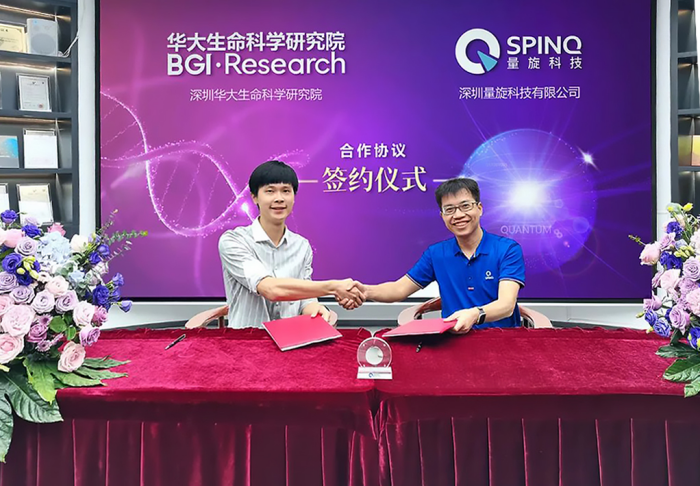BGI-Research: Cracking the Genome Assembly Challenge Using VQE Algorithms
2023.06.26 · Press Release
The rapid evolution of quantum computing in recent years has unlocked transformative potential within the life sciences, from expediting drug development cycles to advancing personalized cancer therapies. BGI-Research and SpinQ have forged a strategic partnership to delve into quantum computing's role in life sciences. Harnessing quantum algorithms for genome assembly not only adeptly addresses the complex challenges of genome assembly but also enables the simulation of larger quantum systems with fewer quantum resources, offering a glimpse into large-scale system simulation during the NISQ era.
Traditional Genome Assembly Methods are Facing Many Challenges
Founded in 1999 as a result of the Human Genome Project, BGI(The Beijing Genomics Institute) is one of the world's leading life sciences frontline organizations, leading the innovative development of genomics through the integration of industry, academia, and research. Through its branches in more than 100 countries and regions around the world, BGI promotes the transformation of gene science and technology achievements and realizes the benefits of gene science and technology to mankind.
As BGI's core research arm, BGI-Research concentrates on cutting-edge directions and pivotal issues in genomics-based foundational research, including explorations of bioinformatics-quantum computing integration.
Gene sequencing, a cornerstone for unraveling life's mysteries, aids in understanding life's origins, tracking evolutionary paths, and uncovering disease mechanisms, thereby facilitating early intervention and personalized medicine.
However, due to sequencing technology limitations, the length of DNA sequences obtainable is significantly shorter than actual genome sizes. For instance, while the human genome spans approximately 3G (3 billion base pairs), mainstream second-generation sequencing technology typically yields read lengths between 100bp and 300bp.
Researchers often employ a "shotgun" approach to randomly fragment the entire genome into manageable gene pieces, sequence these fragments, and then use genome assembly techniques to reconstruct the complete genome from the massive datasets.
Complex genomic regions with numerous repetitive sequences and high heterozygosity often stymie assembly efforts, impacting final results.
Current methods, OLC (Overlap-Layout-Consensus) and DBG (De Bruijn Graph), fall short in tackling these challenges. Classical algorithms also grapple with data storage and computational demands, especially when reference genomes are absent, leading to infeasible computation times. Dr. Junhan Huang, head of BGI-Research's quantum computing team, noted the necessity for innovative solutions beyond classical approaches.
Uniting with SpinQ to Harness Variational Quantum Algorithms for Genome Sequencing
Recognizing quantum computing's potential to revolutionize life sciences, BGI-Research and SpinQ embarked on a collaborative R&D initiative in July 2022. This partnership aims to establish benchmarks for quantum computing in life sciences, focusing on applying quantum algorithms to genome assembly.

Dr Junhan Huang, Quantum Computing Team Leader, BGI-Research,
and Dr Xiang Jingen, Founder & CEO, SpinQ
Given the complexities of implementing quantum algorithms for genome assembly, both entities contributed their expertise. BGI-Research specializes in biological problem modeling, while SpinQ develops quantum algorithms, exploring a novel genome assembly methodology:
1.Transforming genome assembly into a combinatorial optimization issue, mapping sequenced fragments into a directed graph to solve the optimal path problem.
2.Mathematically formulating the combinatorial optimization and translating it into Hamiltonian terms using the variational quantum algorithm—an approximate optimization approach considered highly promising for practical quantum applications.
3.Solving for the Hamiltonian's optimal eigenvalues and states, then decoding these to reveal the optimal genome assembly path.
It is worth mentioning that this new method makes full use of the superposition and entanglement of quantum by using distributed quantum-classical hybrid algorithms, which can effectively improve the computational power and simulate larger quantum systems using less quantum resources, solving the problem of excessive consumption of computational resources during the assembly of high-throughput gene sequencing, and also providing the possibility of simulating in the NISQ era (the era of medium-sized noise-containing quantum) It also provides the possibility of simulating large-scale systems in the NISQ era (medium-scale noise-containing quantum era).
Quantum Computing: A Catalyst for Life Science Advancements
Beyond genome assembly, quantum computing holds broad potential across life sciences, including drug discovery, medicine, and molecular biology. For instance, in drug development, quantum computing can model biochemical reactions with precision, streamlining the identification of efficient drug molecules and accelerating the R&D process.
Surveys indicate an overwhelming majority of life science companies foresee a positive industry impact from quantum computing within the decade. As quantum computing applications unfold, pharmaceutical and healthcare entities are increasingly investing in this technology, with Novo Nordisk allocating $200 million for quantum computing in drug discovery and Cleveland Clinic, alongside IBM, deploying a quantum computer for biomedical research.
Quantum computing's distinct advantages are set to innovate life science challenges, heralding a transformative era. As it reshapes traditional life science research, we anticipate significant breakthroughs and enhanced contributions to human health and well-being.
Contact Us
Featured Content
Popular Reads





.png)
